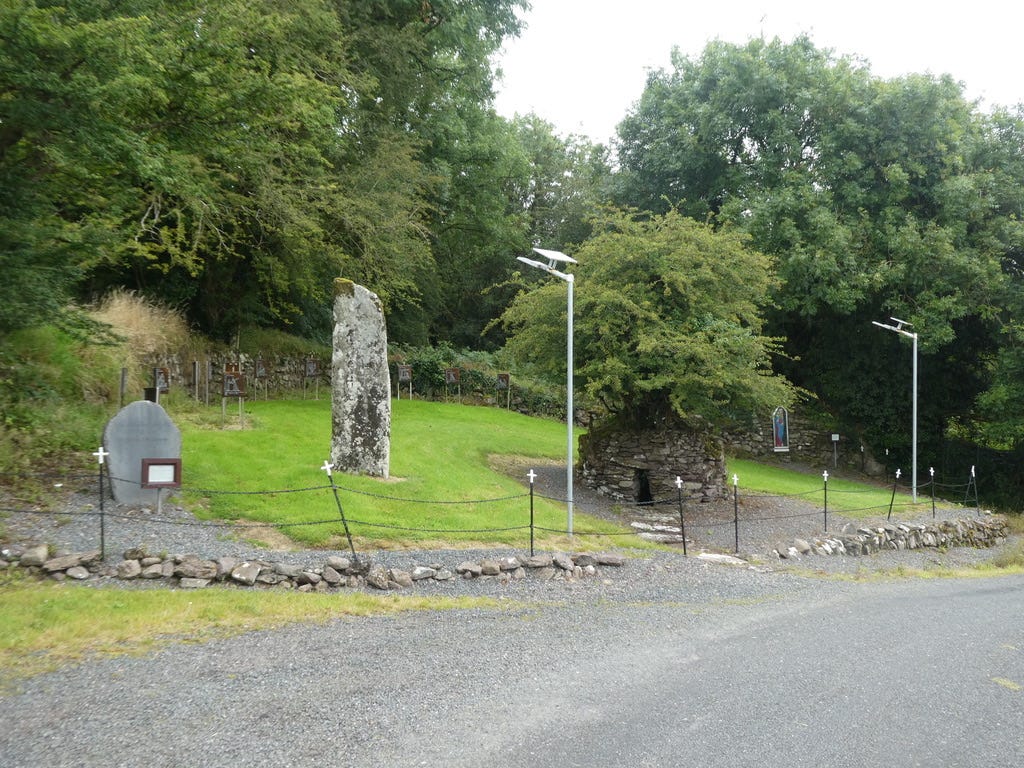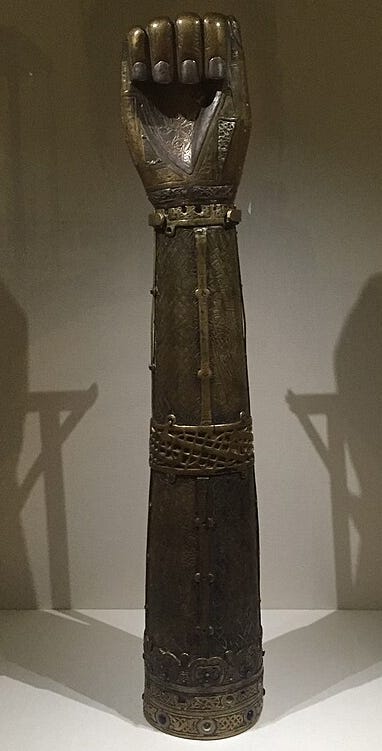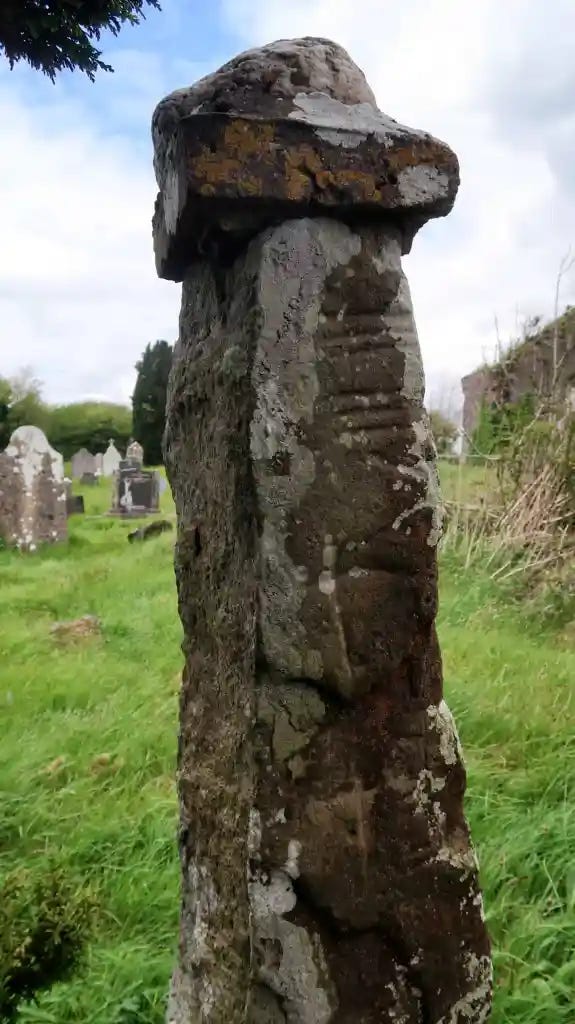St Olan’s Well, Aghabulloge, County Cork
Here we have something interesting: a well that is more than a well. We also have, quite probably, a well that is older than the Christian faith’s arrival in Ireland. Nestled in a layby down a County Cork lane, and lit by a couple of new, ugly, solar-powered streetlamps that look like they ought to be propping up a bevvy of drunks after closing time in central Dublin, St Olan’s well is an intriguing place, with a lot of layers of history and myth to unpeel.
First, let’s examine the well and its saint. St Olan, or Eulang in Irish, is a very local saint, who is patron of this parish, Aghabulloge. Not much is written about him, but the stories we do have suggest some less than saintly behaviour on his part. The local schoolchildren of the 1930s recorded the story of his feud with a saintly rival, St Lachteen, or Lachtáin:
St Olan and St Lachtáin were very great friends until a certain thing happened. Both agreed that what each would walk on the morrow would be his parish. However, Lachtáin by setting out when it was still dark covered more ground than St Olan and people say that the reason why Donaghmore parish is bigger than Aghabullogue. Both saints cursed each others parishes. St Olan said all the mad dogs would run towards Donaghmore and St Lachtain said that Aghabullogue would never be without robbers.
‘My parish is bigger than yours’ would not normally be a very Christian reason to go around cursing your fellow brothers-in-Christ, but maybe things were different in those days. The feud didn’t end there, either. Olan was still so angry with Lachteen that he added a further, very singular, curse: he prayed that Lachteen’s arm would fall off. When it duly did, Olan was apparently so guilt-stricken that he prayed again, this time for the curse to be reversed. Alas, it was too late: by then, Lachteen’s arm had already turned to bronze:
This is in fact the reliquary of St Lachteen’s arm, and not the arm itself, which is presumably inside. Still, it does seem to have fallen off. So be careful what you pray for, my friends.
Olan might still be cross if he could see today (and maybe he can) that Lachteen has more wells named for him in Ireland than Olan. St Olan, in fact, only has this one. But what a well it is. Its beautiful old drystone beehive wellhouse sprouts a fantastic green fright wig in summer:
This is a hawthorn, or whitethorn, tree, which grows from the top of the wellhouse. The story goes that there was originally an ash growing here - one which sprouted from St Olan’s staff, when he planted it in the well. The ash was later cut down by a local priest. Maybe he was embarrassed by the story about the cursed arm.
Around the rest of the site we find things we might find at many an Irish well: a statue of Mary in a glass case pointing to her sacred heart, as well as the thirteen stations of the cross. But we find something else too, that I’ve never seen at a holy well site before:
This, quite obviously, is a standing stone, and it’s one indication that this may have been a sacred site before St Olan arrived to bless it. Look closely and you’ll see a crude cross carved into the stone. What you can’t see from this picture is that the stone is also notched with Ogham script. Ogham is a very old, pre-Latin alphabet, which seems to pre-date Christianity’s arrival in Ireland. By how long we don’t know, because the experts still argue about quite how old it is, precisely what it was used for, and who exactly used it. My favourite theory is that it was a secret code used by Druids to communicate with each other in a hostile Christian or Roman environment. Another theory, though, is that it was actually developed by early Christians, as a means of communicating with people in Irish.
The long and the short of it is that we don’t know. But we do know that this stone is only one of three that stand very close together in this parish, which suggests that this well may have formed part of a larger sacred landscape. One of the other stones can be found in the local churchyard up the road. You can see the Ogham carvings much more clearly this time. You can also see that - ahem - it is not quite the shape of a typical Christian monument:
This has ‘pagan’ written all over it. Fertility stones, and fertility rites, were a big deal in pre-Christian Ireland. It’s said, for example, that as part of the ritual for swearing in the country’s High King, the monarch would have sex with a live horse on the summit of the Hill of Tara in front of his watching people, in order to demonstrate his potency. The horse would then be killed and cooked, and everyone would eat some. Yum.
The Christians put an end to this sort of malarkey, which was certainly good news for Ireland’s horse population. The stone in this picture ended up Christianised, too. The top of it, known as ‘St Olan’s cap’, apparently comes off. If you put it on your head and walk three times around the church it is said to cure your headache - though I would have thought it would be more likely to give you one.
The well itself can be found by poking your head into the little doorway in the hobbity wellhouse. It is said that a blessed frog once lived here. I would give a lot to see a blessed frog.
St Olan’s well is a peaceful spot today: obviously well-tended (sorry) but quiet and hidden away, with no mad dogs or fertility rites in sight. How times change.












I see the makings of a fantastic Monty Python skit in all this. Suggested cast:
St Olan - Eric Idle
St Lachteen - Michael Palin
Old Pagan Lady and Keeper of the Holy Phallus - Graham Chapman
"Ey! Ey you two! Stop mucking about with the Holy Phallus before I whack you with this shillelagh!"
I too would like to see a blessed frog!